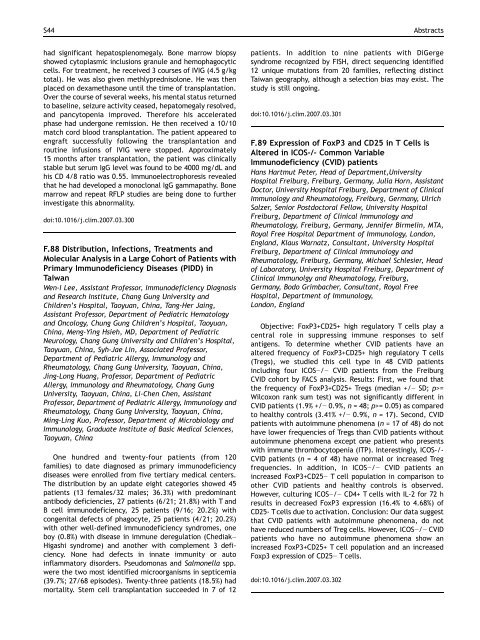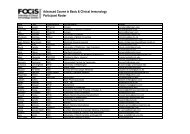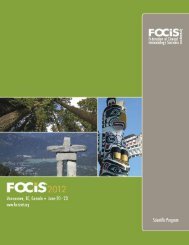Oral Presentations - Federation of Clinical Immunology Societies
Oral Presentations - Federation of Clinical Immunology Societies
Oral Presentations - Federation of Clinical Immunology Societies
Create successful ePaper yourself
Turn your PDF publications into a flip-book with our unique Google optimized e-Paper software.
S44 Abstracts<br />
had significant hepatosplenomegaly. Bone marrow biopsy<br />
showed cytoplasmic inclusions granule and hemophagocytic<br />
cells. For treatment, he received 3 courses <strong>of</strong> IVIG (4.5 g/kg<br />
total). He was also given methlyprednisolone. He was then<br />
placed on dexamethasone until the time <strong>of</strong> transplantation.<br />
Over the course <strong>of</strong> several weeks, his mental status returned<br />
to baseline, seizure activity ceased, hepatomegaly resolved,<br />
and pancytopenia improved. Therefore his accelerated<br />
phase had undergone remission. He then received a 10/10<br />
match cord blood transplantation. The patient appeared to<br />
engraft successfully following the transplantation and<br />
routine infusions <strong>of</strong> IVIG were stopped. Approximately<br />
15 months after transplantation, the patient was clinically<br />
stable but serum IgG level was found to be 4000 mg/dL and<br />
his CD 4/8 ratio was 0.55. Immunoelectrophoresis revealed<br />
that he had developed a monoclonal IgG gammapathy. Bone<br />
marrow and repeat RFLP studies are being done to further<br />
investigate this abnormality.<br />
doi:10.1016/j.clim.2007.03.300<br />
F.88 Distribution, Infections, Treatments and<br />
Molecular Analysis in a Large Cohort <strong>of</strong> Patients with<br />
Primary Immunodeficiency Diseases (PIDD) in<br />
Taiwan<br />
Wen-I Lee, Assistant Pr<strong>of</strong>essor, Immunodeficiency Diagnosis<br />
and Research Institute, Chang Gung University and<br />
Children’s Hospital, Taoyuan, China, Tang-Her Jaing,<br />
Assistant Pr<strong>of</strong>essor, Department <strong>of</strong> Pediatric Hematology<br />
and Oncology, Chung Gung Children’s Hospital, Taoyuan,<br />
China, Meng-Ying Hsieh, MD, Department <strong>of</strong> Pediatric<br />
Neurology, Chang Gung University and Children’s Hospital,<br />
Taoyuan, China, Syh-Jae Lin, Associated Pr<strong>of</strong>essor,<br />
Department <strong>of</strong> Pediatric Allergy, <strong>Immunology</strong> and<br />
Rheumatology, Chang Gung University, Taoyuan, China,<br />
Jing-Long Huang, Pr<strong>of</strong>essor, Department <strong>of</strong> Pediatric<br />
Allergy, <strong>Immunology</strong> and Rheumatology, Chang Gung<br />
University, Taoyuan, China, Li-Chen Chen, Assistant<br />
Pr<strong>of</strong>essor, Department <strong>of</strong> Pediatric Allergy, <strong>Immunology</strong> and<br />
Rheumatology, Chang Gung University, Taoyuan, China,<br />
Ming-Ling Kuo, Pr<strong>of</strong>essor, Department <strong>of</strong> Microbiology and<br />
<strong>Immunology</strong>, Graduate Institute <strong>of</strong> Basic Medical Sciences,<br />
Taoyuan, China<br />
One hundred and twenty-four patients (from 120<br />
families) to date diagnosed as primary immunodeficiency<br />
diseases were enrolled from five tertiary medical centers.<br />
The distribution by an update eight categories showed 45<br />
patients (13 females/32 males; 36.3%) with predominant<br />
antibody deficiencies, 27 patients (6/21; 21.8%) with T and<br />
B cell immunodeficiency, 25 patients (9/16; 20.2%) with<br />
congenital defects <strong>of</strong> phagocyte, 25 patients (4/21; 20.2%)<br />
with other well-defined immunodeficiency syndromes, one<br />
boy (0.8%) with disease in immune deregulation (Chediak–<br />
Higashi syndrome) and another with complement 3 deficiency.<br />
None had defects in innate immunity or auto<br />
inflammatory disorders. Pseudomonas and Salmonella spp.<br />
were the two most identified microorganisms in septicemia<br />
(39.7%; 27/68 episodes). Twenty-three patients (18.5%) had<br />
mortality. Stem cell transplantation succeeded in 7 <strong>of</strong> 12<br />
patients. In addition to nine patients with DiGerge<br />
syndrome recognized by FISH, direct sequencing identified<br />
12 unique mutations from 20 families, reflecting distinct<br />
Taiwan geography, although a selection bias may exist. The<br />
study is still ongoing.<br />
doi:10.1016/j.clim.2007.03.301<br />
F.89 Expression <strong>of</strong> FoxP3 and CD25 in T Cells is<br />
Altered in ICOS-/- Common Variable<br />
Immunodeficiency (CVID) patients<br />
Hans Hartmut Peter, Head <strong>of</strong> Department,University<br />
Hospital Freiburg, Freiburg, Germany, Julia Horn, Assistant<br />
Doctor, University Hospital Freiburg, Department <strong>of</strong> <strong>Clinical</strong><br />
<strong>Immunology</strong> and Rheumatology, Freiburg, Germany, Ulrich<br />
Salzer, Senior Postdoctoral Fellow, University Hospital<br />
Freiburg, Department <strong>of</strong> <strong>Clinical</strong> <strong>Immunology</strong> and<br />
Rheumatology, Freiburg, Germany, Jennifer Birmelin, MTA,<br />
Royal Free Hospital Department <strong>of</strong> <strong>Immunology</strong>, London,<br />
England, Klaus Warnatz, Consultant, University Hospital<br />
Freiburg, Department <strong>of</strong> <strong>Clinical</strong> <strong>Immunology</strong> and<br />
Rheumatology, Freiburg, Germany, Michael Schlesier, Head<br />
<strong>of</strong> Laboratory, University Hospital Freiburg, Department <strong>of</strong><br />
<strong>Clinical</strong> Immunolgy and Rheumatology, Freiburg,<br />
Germany, Bodo Grimbacher, Consultant, Royal Free<br />
Hospital, Department <strong>of</strong> <strong>Immunology</strong>,<br />
London, England<br />
Objective: FoxP3+CD25+ high regulatory T cells play a<br />
central role in suppressing immune responses to self<br />
antigens. To determine whether CVID patients have an<br />
altered frequency <strong>of</strong> FoxP3+CD25+ high regulatory T cells<br />
(Tregs), we studied this cell type in 48 CVID patients<br />
including four ICOS−/− CVID patients from the Freiburg<br />
CVID cohort by FACS analysis. Results: First, we found that<br />
the frequency <strong>of</strong> FoxP3+CD25+ Tregs (median +/− SD; p>=<br />
Wilcoxon rank sum test) was not significantly different in<br />
CVID patients (1.9% +/− 0.9%, n = 48; p>= 0.05) as compared<br />
to healthy controls (3.41% +/− 0.9%, n = 17). Second, CVID<br />
patients with autoimmune phenomena (n = 17 <strong>of</strong> 48) do not<br />
have lower frequencies <strong>of</strong> Tregs than CVID patients without<br />
autoimmune phenomena except one patient who presents<br />
with immune thrombocytopenia (ITP). Interestingly, ICOS-/-<br />
CVID patients (n = 4 <strong>of</strong> 48) have normal or increased Treg<br />
frequencies. In addition, in ICOS−/− CVID patients an<br />
increased FoxP3+CD25− T cell population in comparison to<br />
other CVID patients and healthy controls is observed.<br />
However, culturing ICOS−/− CD4+ T cells with IL-2 for 72 h<br />
results in decreased FoxP3 expression (16.4% to 4.68%) <strong>of</strong><br />
CD25- T cells due to activation. Conclusion: Our data suggest<br />
that CVID patients with autoimmune phenomena, do not<br />
have reduced numbers <strong>of</strong> Treg cells. However, ICOS−/− CVID<br />
patients who have no autoimmune phenomena show an<br />
increased FoxP3+CD25+ T cell population and an increased<br />
Foxp3 expression <strong>of</strong> CD25− T cells.<br />
doi:10.1016/j.clim.2007.03.302




